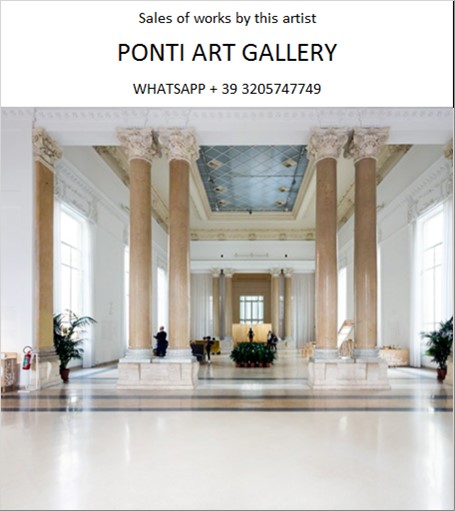Ponti Art Gallery is interested in buying and selling works
of art by this artist.

Christian Marclay Biography
Christian Marclay is a Swiss-American visual artist and composer renowned for his innovative work that bridges the gap between audio and visual art forms. Born on January 11, 1955, in San Rafael, California, Marclay was raised in Geneva, Switzerland, where he was exposed to a diverse range of cultural influences. His father's Swiss heritage and his mother's American background provided him with a unique perspective that has informed his artistic practice.
Marclay's early education took place at the École Supérieure d'Art Visuel in Geneva from 1975 to 1977, where he began to develop his artistic voice. He then continued his studies in the United States, attending the Massachusetts College of Art and Design in Boston, where he earned a Bachelor of Fine Arts in 1980. During his time in Boston, he was part of the Studio for Interrelated Media Program, which allowed him to explore the interplay between different artistic disciplines. He also studied at the Cooper Union in New York in 1978, further honing his skills and conceptual approach.
From the outset of his career, Marclay was drawn to the energy and DIY ethos of punk rock, which influenced his approach to art-making. He began experimenting with performance art, incorporating prerecorded and mechanical sounds produced by vinyl records played on turntables. This experimentation with sound became a central focus of his work, leading him to become a pioneer in the use of gramophone records and turntables as musical instruments. His innovative techniques were developed independently but roughly parallel to the emergence of hip-hop's use of turntablism.
Marclay's work often involves the deconstruction and recontextualization of recorded media. His series "Recycled Records" (1980–86) saw him slicing apart vinyl records and reassembling the fragments to create new sequences of sound. This avant-garde approach to manipulating records was considered groundbreaking and contributed to his reputation as an influential figure in the world of experimental music and art.
Throughout the 1980s, Marclay collaborated with notable musicians such as John Zorn and the band Sonic Youth, and he became known as an avant-garde deejay or "turntablist" in New York City. His performances and installations often featured a playful yet critical examination of music and the technologies involved in its production. For example, in "Tape Fall" (1989), a reel-to-reel tape player mounted on a stepladder played a recording of dripping water while the spent tape accumulated on the floor, creating a visual and auditory experience.
Marclay's "Body Mix" series (1991–92) further showcased his interest in the commodification of popular music, where he stitched together various album covers featuring human bodies to form new, hybrid figures. His work often includes a whimsical transformation of musical instruments, such as in "Lip Lock" (2000), where he fused the mouthpieces of a tuba and a trumpet.
In the realm of video art, Marclay gained significant attention for works like "Telephones" (1995), a montage of clips from Hollywood films featuring characters using telephones, and "Video Quartet" (2002), a four-screen mashup of musical performances and sounds from films. However, it was his 24-hour video piece "The Clock" (2010) that marked a career apex. "The Clock" is composed of cinematic clips that reference time, synchronized with the actual local time, and earned Marclay the prestigious Golden Lion award at the 54th Venice Biennale in 2011.
Marclay's work has been exhibited in numerous prestigious institutions worldwide, including the Hirshhorn Museum and Sculpture Garden in Washington D.C., the Museum of Contemporary Art in Chicago, the San Francisco Museum of Modern Art, the Whitney Museum of American Art in New York, and the Centre Georges Pompidou in Paris. His art is also part of public collections at the Metropolitan Museum of Art in New York, the Smithsonian American Art Museum in Washington D.C., the Tate Modern in London, and the Centre Georges Pompidou in Paris.
Living and working between New York and London, Marclay continues to explore the humor and limits of onomatopoeia through various media, including print, painting, and collage. His work remains a testament to the power of combining visual art with sound, creating immersive experiences that challenge and engage audiences around the world.
Christian Marclay Quotes and
Sales of Works
Ponti Art Gallery selects and deals with paintings by the
artist. Upon request, we provide free estimates and
evaluations, communicate prices, quotations, and current
market values.
If you are interested in BUYING or SELLING works by the
artist, contact us immediately.
If you wish to sell or receive an evaluation of the
works:
Send us a frontal photo of the painting, one of the back,
and one of the signature. Also, indicate the dimensions of
the work. Inform us about the purchase origin of the work
and any kind of available documentation (purchase
receipts, certificates of authenticity, publications). One
of our operators will respond to you on the same day. We
guarantee maximum confidentiality and extreme
professionalism.
If you wish to purchase works by the painter: Contact us
and let us know your request. We will inform you about the
available works. We also offer the possibility to
subscribe to our NEWSLETTER, through which you will be
informed at the beginning of each month about the latest
acquisitions of the art gallery.
You can send us pictures of the work:
